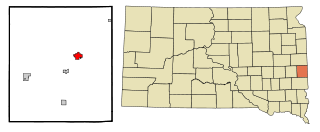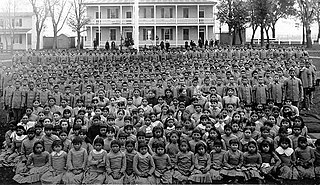Related Research Articles

FlandreauFLAN-droo is a city in and county seat of Moody County, South Dakota, United States. The population was 2,372 at the 2020 census. It was named in honor of Charles Eugene Flandrau, a judge in the territory and state of Minnesota. He is credited with saving the community of New Ulm, Minnesota, from destruction during conflict with the Sioux tribe in 1862.

Pipestone National Monument is located in southwestern Minnesota, just north of the city of Pipestone, Minnesota. It is located along the highways of U.S. Route 75, Minnesota State Highway 23 and Minnesota State Highway 30. The quarries are culturally significant to 23 tribal nations of North America. Those known to actually occupied the site chronologically are the Yankton Dakota, Iowa, and Omaha peoples. The Quarries were considered a neutral territory in the historic past where all tribal nations could quarry stone for ceremonial pipes. The catlinite, or "pipestone", is traditionally used to make ceremonial pipes. They are vitally important to Plains Indian traditional practices. Archeologists believe the site has been in use for over 3000 years with Minnesota pipestone having been found in ancient North American burial mounds across a large geographic area.

The Rosebud Indian Reservation is an Indian reservation in South Dakota, United States. It is the home of the federally recognized Rosebud Sioux Tribe, who are Sicangu, a band of Lakota people. The Lakota name Sicangu Oyate translates as the "Burnt Thigh Nation", also known by the French term, the Brulé Sioux.

The Diocese of Sioux Falls is a Latin Church diocese of the Catholic Church diocese in South Dakota in the United States. It is a suffragan see of the metropolitan Archdiocese of Saint Paul and Minneapolis.

The Fort Peck Indian Reservation is located near Fort Peck, Montana, in the northeast part of the state. It is the home of several federally recognized bands of Assiniboine, Lakota, and Dakota peoples of Native Americans.

The Spirit Lake Tribe is a federally recognized tribe based on the Spirit Lake Dakota Reservation located in east-central North Dakota on the southern shores of Devils Lake. It is made up of people of the Pabaksa (Iháŋkthuŋwaŋna), Sisseton (Sisíthuŋwaŋ) and Wahpeton (Waȟpéthuŋwaŋ) bands of the Dakota tribe. Established in 1867 in a treaty between Sisseton-Wahpeton Bands and the United States government, the reservation, at 47°54′38″N98°53′01″W, consists of 1,283.777 square kilometres (495.669 sq mi) of land area, primarily in Benson and Eddy counties. Smaller areas extend into Ramsey, Wells and Nelson counties.

The Sisseton Wahpeton Oyate of the Lake Traverse Reservation, formerly Sisseton-Wahpeton Sioux Tribe/Dakota Nation, is a federally recognized tribe comprising two bands and two subdivisions of the Isanti or Santee Dakota people. They are on the Lake Traverse Reservation in northeast South Dakota.

American Indian boarding schools, also known more recently as American Indian residential schools, were established in the United States from the mid-17th to the early 20th centuries with a primary objective of "civilizing" or assimilating Native American children and youth into Anglo-American culture. In the process, these schools denigrated Native American culture and made children give up their languages and religion. At the same time the schools provided a basic Western education. These boarding schools were first established by Christian missionaries of various denominations. The missionaries were often approved by the federal government to start both missions and schools on reservations, especially in the lightly populated areas of the West. In the late 19th and early 20th centuries especially, the government paid religious orders to provide basic education to Native American children on reservations, and later established its own schools on reservations. The Bureau of Indian Affairs (BIA) also founded additional off-reservation boarding schools based on the assimilation model. These sometimes drew children from a variety of tribes. In addition, religious orders established off-reservation schools.
Eugene Buechel was born on October 20, 1874, in Schleida, now Schleid, in the Grand Duchy of Saxe-Weimar-Eisenach, Germany, and died October 27, 1954, in O'Neill, Nebraska, United States. Buechel was a Jesuit priest and missionary, linguist and anthropologist among the Brulé or Sicangu Lakota or Sioux on the Rosebud Indian Reservation and the related Oglala Lakota or Sioux on the Pine Ridge Indian Reservation in South Dakota.
The Rapid City Indian Health Service Hospital formerly known as The Sioux San Hospital is an Indian Health Service hospital located in Rapid City, South Dakota. It was built in 1898 as a boarding school for Native Americans and turned into a sanitarium in 1933.

The Bureau of Indian Education (BIE), headquartered in the Main Interior Building in Washington, D.C., and formerly known as the Office of Indian Education Programs (OIEP), is a division of the U.S. Department of the Interior under the Assistant Secretary for Indian Affairs. It is responsible for the line direction and management of all BIE education functions, including the formation of policies and procedures, the supervision of all program activities, and the approval of the expenditure of funds appropriated for BIE education functions.

The Morris Industrial School for Indians (1887–1909) was a Native American boarding school in Morris, Minnesota, United States. The school was founded and run by Roman Catholic nuns of the Sisters of Mercy order from 1887 until 1896. After that, the school was run by the Office of Indian Affairs of the United States Federal Government from 1898 until 1909.
St. Joseph's Indian School is an American Indian boarding school, run by the Congregation of the Priests of the Sacred Heart just outside the city of Chamberlain, South Dakota, on the east side of the Missouri River. The school, located in the Roman Catholic Diocese of Sioux Falls and named after Saint Joseph, is operated by a religious institute of pontifical right that is independent of the diocese. The school is within two hours of three reservations of the Lakota people: the Cheyenne River Indian Reservation, the Lower Brule Indian Reservation and the Crow Creek Indian Reservation, whose children comprise the majority of students at the school. The Akta Lakota Museum and Cultural Center is located on the campus and is owned by the school.
Concho Indian Boarding School was a boarding school for members of the Cheyenne and Arapaho Tribes. It initially served grades 1–6, and later extended classes through grade 8. Admission was later opened to other Native American students.
This timeline of South Dakota is a list of events in the history of South Dakota by year.

The Rapid City Indian School was located in Rapid City, South Dakota, and has since been converted into both an asylum and a hospital known as the Sioux San Hospital. The school opened 1898 as part of the federal government's off-reservation boarding school movement for Native Americans and was shut down in 1933 to become a tuberculosis center. The hospital in the past few years has been listed on the market and is currently being considered for demolition, even though local tribes had tried to claim back the land in the past.
Columbus College was a private Catholic college that operated in South Dakota from 1909 to 1929. Founded by Bishop O'Gorman of the Catholic diocese of Sioux Falls, South Dakota, the school opened in 1909 in Chamberlain, South Dakota. The facility, a former Indian boarding school, was transferred by the federal government to the Catholic Church for "college purposes".
Flandreau Indian School (FIS), previously Flandreau Indian Vocational High School, is a boarding school for Native American children in unincorporated Moody County, South Dakota, adjacent to Flandreau. It is operated by the Bureau of Indian Education (BIE) and is off-reservation.
Circle of Nations Wahpeton Indian School, formerly Wahpeton Indian School, is a tribally-controlled grade 4-8 school in Wahpeton, North Dakota.
Pierre Indian Learning Center (PILC), also known as Pierre Indian School Learning Center, is a grade 1-8 tribal boarding school in Pierre, South Dakota. It is affiliated with the Bureau of Indian Education (BIE).
References
Notes
- ↑ Riney (1999), pp. 9-10.
- 1 2 Farrow, Mary (January 30, 2020). "This unique Catholic school has served Native American students since 1927". The Catholic Telegraph . Retrieved January 5, 2021.
- 1 2 3 Report of the Commissioner of Education [with Accompanying Papers]. Vol. 2. U.S. Government Printing Office. 1909. p. 925.
- ↑ Riney (1999), p. 24
- ↑ South Dakota Historical Collections. Vol. 5. State Publishing Company. 1910. p. 59.
- ↑ Report of the Superintendent of Indian Schools (1901). U.S. Government Printing Office. 1898–1904. pp. 4, 6, 7.
- ↑ Annual Report. Vol. 2. U.S. Government Printing Office. 1907. p. 1192.
- ↑ Riney (1999), p. 14.
Bibliography
- Riney, Scott (1999). The Rapid City Indian School, 1898-1933. University of Oklahoma Press. ISBN 9780806131627.